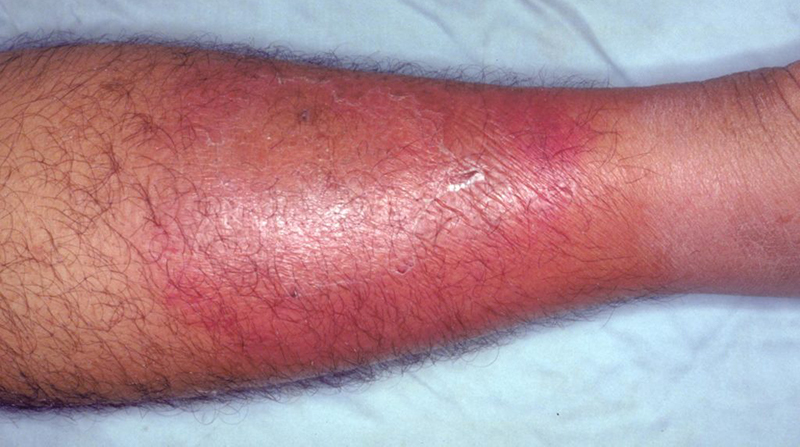
Practice Perfect 651
The Top 10 Myths About Cellulitis
The Top 10 Myths About Cellulitis

One of the most challenging aspects of being a podiatrist is educating physicians about lower extremity infections when we know more, but the consulting doctors don’t heed our advice. My service was recently consulted to see a patient in the hospital admitted for cellulitis of the lower extremity. The patient had a history of congestive heart failure and chronic lower extremity edema. The patient also had a superficial ulcer on the dorsal second toe (Figure 1).


The medicine service started the patient on vancomycin, Zosyn®, and tazobactam, and an infectious disease doctor was also consulted who recommended a three-phase bone scan for suspected osteomyelitis, despite a complete lack of all indications (including a negative radiograph, no fever, and no leukocytosis). You may also notice the clinical images showing a complete lack of cellulitis. I’ll bet good money that almost all podiatrists who do hospital work can relate multiple experiences just like this. It’s no wonder that 30.5% of patients in the emergency room are misdiagnosed with cellulitis, and of these 84.6% are unnecessarily admitted with 92.3% inappropriately receiving antibiotics.1
Situations like this patient’s unfortunate overtreatment make me love articles like The Top 10 Myths Regarding the Diagnosis and Treatment of Cellulitis by McCreary and colleagues.2 This article checks all the myths and sacred cow boxes that drive me crazy. Let’s take a look at a short summary of McCreary’s well-considered myths with some additional comments and considerations.
- Red, swollen skin is definitely cellulitis - Erythema is a nonspecific finding of inflammation and not always infection. A common example is chronic venous insufficiency causing venous stasis dermatitis.
- Bilateral lower extremity swelling is cellulitis - This just makes no sense. How likely is it that both legs would be infected at the same time? Other diagnoses should be considered, the most likely of which is dermatitis from cardiac, renal, or hepatic disorders or chronic venous insufficiency.
- All skin and soft tissue infections require antibiotics - Small, focal abscesses often require incision and drainage. The obvious example is an ingrown toenail, which almost never requires antibiotics. A simple nail avulsion will immediately resolve the “cellulitis”.
- Due to the increased prevalence of MRSA in the community, all clinically stable patients with cellulitis should be covered for MRSA - Coverage for MRSA should be considered based on several factors such as severity, presence of purulence (Staph is more commonly purulent versus Strep), likely infecting agents, and MRSA risk factors (prior history of MRSA, recurrent disease, crowded living conditions, sports participation, poor response to beta-lactam antibiotics, IV drug abuse, and shaving body hair).
- Patients admitted with cellulitis should be covered for MRSA - Same as number 4, but if the patient is sick enough and the hospital MRSA local population is high, it may be prudent to start with MRSA coverage and immediately change based on culture results.
- Clindamycin is an effective antibiotic against MRSA - There are a couple of issues here. The first is the high risk for pseudomembranous colitis with clindamycin. The second is the inducible resistance that may occur with clindamycin. The D-test should be done on cultures, and a D-shaped disk appearance using the disk diffusion method showing resistance may occur via a cross reaction with erythromycin.3 If the D-test is positive, clindamycin should not be used. Bactrim™ and doxycycline both have less inducible resistance than clindamycin and are good oral alternatives.
- Because one cannot tell what organism is responsible for the cellulitis, broad spectrum coverage is necessary - Staph and strep are the most common infecting agents in lower extremity infections, so empiric coverage for these is appropriate. Pseudomonas species are usually contaminants, and gram-negative coverage is usually unnecessary. Long-standing diabetic foot wounds may be polymicrobial, but gram negative and anaerobic infections are still in the minority. The addition of multiple or broader spectrum antibiotics should be determined based on patient specific factors, a detailed history and physical, and culture results.
- If the infection is spreading past the marked wound margin, the cellulitis is worsening - Erythema may continue to spread for a short time after the start of antibiotics, and this does not represent treatment failure. Worsening intensity of erythema or spreading erythema beyond 48-72 hours are better markers.
- Patients taking antibiotics for prophylaxis against recurrent skin infections will not have another infection - Concomitant skin issues such as tinea infections, xerosis, fissuring, and chronic edema may leave the skin open to recurrent infections despite the patient taking an antibiotic.
- Patients with tick bites and surrounding erythema have cellulitis - A small rim of erythema is common with insect bites and does not mean cellulitis is present. The target lesion of erythema chronicum migrans is easily differentiated from a staph or strep cellulitis.
I can’t resist adding one final myth that still seems to have some staying power, which is the possibility of hematogenous infection to the foot in the adult patient. This just doesn’t happen. Since infection in the foot almost always occurs from contiguous spread, if there is no break in the skin, then the chances of an infectious cause of erythema is almost nonexistent. In diabetic patients presenting with a red, hot swollen foot without any skin opening, the primary diagnosis should be Charcot arthropathy until proven otherwise.
We all have pet peeves, but unfortunately these myths are potentially damaging to our patients. Good luck educating those who know less than you but fail to heed your recommendations.

-
Weng QY, Raff AB, Cohen JM, et al. Costs and Consequences Associated with Misdiagnosed Lower Extremity Cellulitis. JAMA Dermatol. 2016 Nov 2;153(2):141-146.
Follow this link -
McCreary EK, Heim ME, Schulz LT, Hoffman R, et al. Top 10 Myths Regarding the Diagnosis and Treatment of Cellulitis. J Emerg Med. 2017 Oct:485-492.
Follow this link -
Woods CR. Macrolide-Inducible Resistance to Clindamycin and the D-Test. Pediatr Infect Disease J. 2009 Dec;28(12):1115-1118.
Follow this link































Comments
There are 0 comments for this article